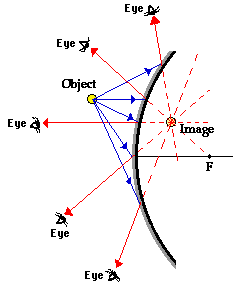Mirrors
- Page ID
- 259
\( \newcommand{\vecs}[1]{\overset { \scriptstyle \rightharpoonup} {\mathbf{#1}} } \)
\( \newcommand{\vecd}[1]{\overset{-\!-\!\rightharpoonup}{\vphantom{a}\smash {#1}}} \)
\( \newcommand{\dsum}{\displaystyle\sum\limits} \)
\( \newcommand{\dint}{\displaystyle\int\limits} \)
\( \newcommand{\dlim}{\displaystyle\lim\limits} \)
\( \newcommand{\id}{\mathrm{id}}\) \( \newcommand{\Span}{\mathrm{span}}\)
( \newcommand{\kernel}{\mathrm{null}\,}\) \( \newcommand{\range}{\mathrm{range}\,}\)
\( \newcommand{\RealPart}{\mathrm{Re}}\) \( \newcommand{\ImaginaryPart}{\mathrm{Im}}\)
\( \newcommand{\Argument}{\mathrm{Arg}}\) \( \newcommand{\norm}[1]{\| #1 \|}\)
\( \newcommand{\inner}[2]{\langle #1, #2 \rangle}\)
\( \newcommand{\Span}{\mathrm{span}}\)
\( \newcommand{\id}{\mathrm{id}}\)
\( \newcommand{\Span}{\mathrm{span}}\)
\( \newcommand{\kernel}{\mathrm{null}\,}\)
\( \newcommand{\range}{\mathrm{range}\,}\)
\( \newcommand{\RealPart}{\mathrm{Re}}\)
\( \newcommand{\ImaginaryPart}{\mathrm{Im}}\)
\( \newcommand{\Argument}{\mathrm{Arg}}\)
\( \newcommand{\norm}[1]{\| #1 \|}\)
\( \newcommand{\inner}[2]{\langle #1, #2 \rangle}\)
\( \newcommand{\Span}{\mathrm{span}}\) \( \newcommand{\AA}{\unicode[.8,0]{x212B}}\)
\( \newcommand{\vectorA}[1]{\vec{#1}} % arrow\)
\( \newcommand{\vectorAt}[1]{\vec{\text{#1}}} % arrow\)
\( \newcommand{\vectorB}[1]{\overset { \scriptstyle \rightharpoonup} {\mathbf{#1}} } \)
\( \newcommand{\vectorC}[1]{\textbf{#1}} \)
\( \newcommand{\vectorD}[1]{\overrightarrow{#1}} \)
\( \newcommand{\vectorDt}[1]{\overrightarrow{\text{#1}}} \)
\( \newcommand{\vectE}[1]{\overset{-\!-\!\rightharpoonup}{\vphantom{a}\smash{\mathbf {#1}}}} \)
\( \newcommand{\vecs}[1]{\overset { \scriptstyle \rightharpoonup} {\mathbf{#1}} } \)
\( \newcommand{\vecd}[1]{\overset{-\!-\!\rightharpoonup}{\vphantom{a}\smash {#1}}} \)
\(\newcommand{\avec}{\mathbf a}\) \(\newcommand{\bvec}{\mathbf b}\) \(\newcommand{\cvec}{\mathbf c}\) \(\newcommand{\dvec}{\mathbf d}\) \(\newcommand{\dtil}{\widetilde{\mathbf d}}\) \(\newcommand{\evec}{\mathbf e}\) \(\newcommand{\fvec}{\mathbf f}\) \(\newcommand{\nvec}{\mathbf n}\) \(\newcommand{\pvec}{\mathbf p}\) \(\newcommand{\qvec}{\mathbf q}\) \(\newcommand{\svec}{\mathbf s}\) \(\newcommand{\tvec}{\mathbf t}\) \(\newcommand{\uvec}{\mathbf u}\) \(\newcommand{\vvec}{\mathbf v}\) \(\newcommand{\wvec}{\mathbf w}\) \(\newcommand{\xvec}{\mathbf x}\) \(\newcommand{\yvec}{\mathbf y}\) \(\newcommand{\zvec}{\mathbf z}\) \(\newcommand{\rvec}{\mathbf r}\) \(\newcommand{\mvec}{\mathbf m}\) \(\newcommand{\zerovec}{\mathbf 0}\) \(\newcommand{\onevec}{\mathbf 1}\) \(\newcommand{\real}{\mathbb R}\) \(\newcommand{\twovec}[2]{\left[\begin{array}{r}#1 \\ #2 \end{array}\right]}\) \(\newcommand{\ctwovec}[2]{\left[\begin{array}{c}#1 \\ #2 \end{array}\right]}\) \(\newcommand{\threevec}[3]{\left[\begin{array}{r}#1 \\ #2 \\ #3 \end{array}\right]}\) \(\newcommand{\cthreevec}[3]{\left[\begin{array}{c}#1 \\ #2 \\ #3 \end{array}\right]}\) \(\newcommand{\fourvec}[4]{\left[\begin{array}{r}#1 \\ #2 \\ #3 \\ #4 \end{array}\right]}\) \(\newcommand{\cfourvec}[4]{\left[\begin{array}{c}#1 \\ #2 \\ #3 \\ #4 \end{array}\right]}\) \(\newcommand{\fivevec}[5]{\left[\begin{array}{r}#1 \\ #2 \\ #3 \\ #4 \\ #5 \\ \end{array}\right]}\) \(\newcommand{\cfivevec}[5]{\left[\begin{array}{c}#1 \\ #2 \\ #3 \\ #4 \\ #5 \\ \end{array}\right]}\) \(\newcommand{\mattwo}[4]{\left[\begin{array}{rr}#1 \amp #2 \\ #3 \amp #4 \\ \end{array}\right]}\) \(\newcommand{\laspan}[1]{\text{Span}\{#1\}}\) \(\newcommand{\bcal}{\cal B}\) \(\newcommand{\ccal}{\cal C}\) \(\newcommand{\scal}{\cal S}\) \(\newcommand{\wcal}{\cal W}\) \(\newcommand{\ecal}{\cal E}\) \(\newcommand{\coords}[2]{\left\{#1\right\}_{#2}}\) \(\newcommand{\gray}[1]{\color{gray}{#1}}\) \(\newcommand{\lgray}[1]{\color{lightgray}{#1}}\) \(\newcommand{\rank}{\operatorname{rank}}\) \(\newcommand{\row}{\text{Row}}\) \(\newcommand{\col}{\text{Col}}\) \(\renewcommand{\row}{\text{Row}}\) \(\newcommand{\nul}{\text{Nul}}\) \(\newcommand{\var}{\text{Var}}\) \(\newcommand{\corr}{\text{corr}}\) \(\newcommand{\len}[1]{\left|#1\right|}\) \(\newcommand{\bbar}{\overline{\bvec}}\) \(\newcommand{\bhat}{\widehat{\bvec}}\) \(\newcommand{\bperp}{\bvec^\perp}\) \(\newcommand{\xhat}{\widehat{\xvec}}\) \(\newcommand{\vhat}{\widehat{\vvec}}\) \(\newcommand{\uhat}{\widehat{\uvec}}\) \(\newcommand{\what}{\widehat{\wvec}}\) \(\newcommand{\Sighat}{\widehat{\Sigma}}\) \(\newcommand{\lt}{<}\) \(\newcommand{\gt}{>}\) \(\newcommand{\amp}{&}\) \(\definecolor{fillinmathshade}{gray}{0.9}\)A mirror is a device that contains a surface used to reflect light.
Because mirrors do not usually absorb much light, most of the light is redirected upon contact with the mirror and the object's overall quality is usually preserved in the new image.
Mirrors come from many materials and have numerous uses.
Materials of Mirrors
PLANE SILVER MIRRORS
This is usually how everyday mirrors are made.
First, this mirror is constructed using a layer of clear, flat glass. The glass is nearly transparent to allow most of the light through.
Second, the glass is backed by a thin layer of silver. The solid silver formed on the glass is from the reduction of a liquid silver nitrate that originally sticks to the glass. The silver absorbs very little light and reflects about 95% of it. When the light hits the silver, it reflects in the same angle that it hit the silver.
Finally, The light rays eventually meet up and a virtual image is formed. (This youtube video shows this concept: http://www.youtube.com/watch?v=0T3CVPlv1D8)

Silver is very commonly used because it is the best reflecter of visible light amongst common metals. It reflects about 95% of visible light in the visible light spectra (400nm - 700nm). Although silver is expensive, a layer of silver 100nm thin is usually enough to achieve the silver's full reflective capability.

Besides the silver mirror described above, mirrors may also be made of other materials. The usefulness of the material depends on the cost of the material and the effectiveness of reflecting the desired light wavelengths present.
Aluminum Mirrors
Aluminium is often substituted for silver. This is for two main reasons. First, Aluminum maintains a high relective ability in the ultraviolet range. This makes it especially useful for outerspace applications. Second, Aluminium is much cheaper than silver.
Aluminum maintains an 88-92% relective ability in the visible spectrum.
Aluminum mirrors are usually made by a process of attaching aluminum to the glass using a vacuum and then covering the aluminum with multuple layers of protective paint.
Gold Coated Mirrors
Gold mirrors are very expensive to make. However, they are very useful in reflecting infared radiation. Gold mirrors can capture 96% of radiation in the 800nm to 20microm spectrum. They are largely useless below 500nm however.
Besides different coatings, mirrors may also take on different shapes.
Mirrors can be either planar (described at the top), concave, or conzex.
Shapes of Mirrors:
Concave Mirrors
A concave mirror is used to focus an image close to the mirror. Images in front of or behind the mirror depending on how far away the image is from the focal point. For more info, visit: http://www.physicsclassroom.com/class/refln/u13l3e.cfm

Convex Mirrors
Convex mirrors are used to create virtual images that form on the other side of the mirror. These mirrors are used as the side mirrors of cars. For more info, visit: http://www.physicsclassroom.com/class/refln/u13l4a.cfm

Uses of Mirrors:
The most common mirror is the plane mirror used for looking at oneself. Other common mirrors include the convex mirrors used on side mirrors for cars and the plane mirror used as the rear mirror for cars. Less common, but very important, every day mirrors include the mirrors located in televisions and projectors.
Take for example, the DLP mirror developed by Texas Instruments: http://www.ti.com/lsds/ti/analog/dlp...dlp-works.page. This is a set of millions of micromirrors that carefully direct light so that it can appear HD on a screen.
Another very important example of mirrors is the mirrors of the hubble telescope. Below is a useful image from http://hubblesite.org/the_telescope/hubble_essentials/image.php?image=light-path:

A final but fascinating use of mirrors is Ivanpah Solar Pland located in the Mojave Desert. http://news.nationalgeographic.com/news/energy/2013/07/130725-ivanpah-solar-energy-mojave-desert/
This is a system in which hundreds or mirrors surrond a water tower. During the day, the mirrors reflect the light into the water tower in the middle of the system. This heats up the water. The water is eventually harvested for energy.

